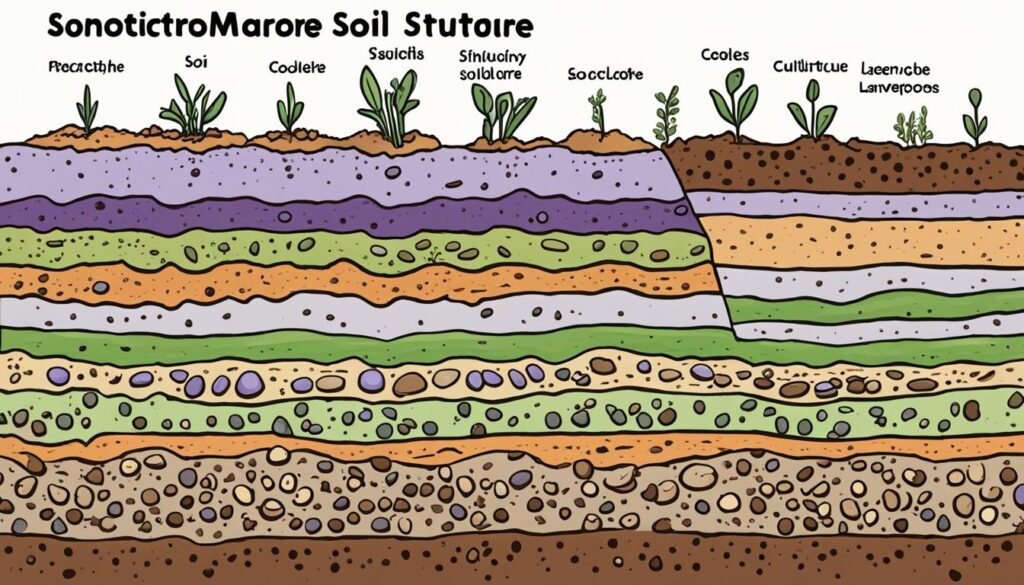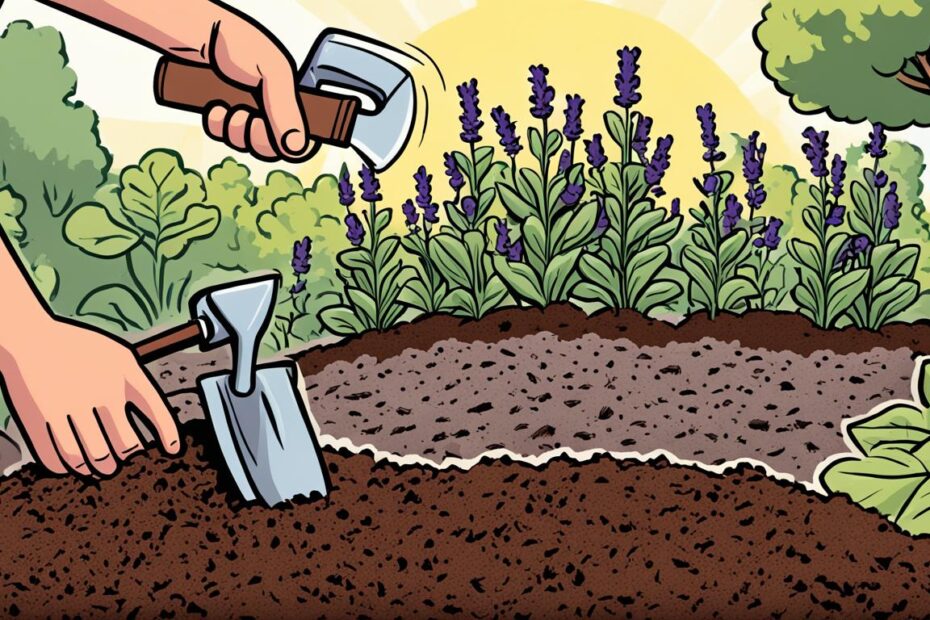Are you struggling to grow healthy and vibrant lavender plants in your garden? Wondering why your lavender doesn’t thrive like the ones you see in those picturesque fields? The secret lies in the soil!
Soil preparation for Lavandula is crucial for the long-term survival and yield of this beautiful and fragrant plant. To achieve the ideal soil for lavender, you need to understand its composition and create the perfect balance of moisture and oxygen.
Key Takeaways:
- Proper soil preparation is essential for successful lavender cultivation.
- An ideal soil for lavender consists of 45% mineral, 5% organic matter, and 50% pore space.
- The balance between moisture and oxygen is crucial for root growth and plant survival.
- Soil texture, structure, and amendments play a significant role in creating the ideal soil environment for lavender.
- By following these soil preparation guidelines, you can cultivate perfect lavender plants that thrive and beautify your garden.
Soil Texture and Water Movement
In order to create the perfect environment for your lavender plantation, it is essential to understand the impact of soil texture on water movement and infiltration. Soil texture refers to the percentage of sand, silt, and clay in the soil, which influences water flow within the soil profile.
Sandy soils, with their larger pores, allow water to infiltrate more quickly compared to clay soils. This means that sandy soils drain more efficiently, preventing waterlogging and potential root rot.
However, it’s crucial to be mindful of excessive watering, as it can cause soil particles to flow into the pores, blocking larger macropores necessary for proper air flow and oxygen exchange.
Proper irrigation management is essential for maintaining healthy soil structure and preventing oxygen-deficient soils in your lavender plantation.
Drip or sprinkler irrigation systems should take into account the soil’s infiltration rate, providing water at a rate that allows for efficient water movement and prevents the blocking of macropores.
| Soil Texture | Water Movement |
|---|---|
| Sandy Soil | Allows for fast water infiltration and drainage |
| Clay Soil | Has smaller pores, slower water movement, and increased water retention |
Soil Structure and Macropores
The arrangement of clay, silt, and clay particles into aggregates creates the soil structure, which greatly influences the movement of water and oxygen.
Macropores, the conduits through which roots and soil microbes survive, are essential for the entry of water and oxygen into the soil, as well as the exit of carbon dioxide. Ensuring the development of macropores is crucial for proper drainage and root health.
Poor soil structure restricts gas exchange, increases the risk of root rot pathogens, and limits root growth. Enhancing the soil structure can be achieved through organic matter amendments, such as compost or wood chips, which help generate soil aggregates and create macropores.
| Benefits of Soil Structure and Macropores |
|---|
| Improved water percolation and drainage |
| Increase in root aeration and oxygen availability |
| Reduction of compaction and waterlogging |
| Enhanced microbial activity |
| Lower risk of root rot pathogens |
Organic Matter Amendments for Soil Structure
Adding organic matter to the soil is a key strategy for improving soil structure and promoting the development of macropores. Coarse compost or wood chips can be incorporated into the soil during the preparation process.
“The addition of organic matter can enhance soil aggregation and create macropores, allowing for improved root growth and nutrient uptake.” – [Expert Name]
These organic amendments provide several benefits:
- Improved soil aggregation
- Enhanced water infiltration
- Promotion of microbial activity
- Increased nutrient availability
By enhancing the soil structure and creating macropores, you can improve root health and optimize the oxygen movement within the soil, reducing the risk of root rot pathogens and promoting healthy growth for your lavender plants.

Soil Amendments and Nutrients
Enhancing your soil with the right amendments and providing essential nutrients is crucial for the optimal growth of your lavender plants. By adding organic matter such as coarse compost or wood chips, you can improve soil structure and create soil aggregates. This promotes the development of a healthy soil ecosystem by enhancing microbial activity and nutrient availability.
Lavender plants require a balanced supply of nitrogen, phosphorus, potassium, and micronutrients to thrive. However, it’s important to note that the addition of phosphorus should be based on a soil test. Excessive phosphorus can tie up other micronutrients and reduce the effectiveness of mycorrhizal fungi, which form a symbiotic relationship with lavender roots, aiding in nutrient uptake.
Applying nutrient amendments only when necessary helps maintain a balanced soil fertility, ensuring that your lavender plants receive the nutrients they need without causing any nutrient imbalances. A soil test is recommended to determine the specific nutrient requirements of your soil and lavender plants.
By enriching your soil with organic matter and providing the right nutrients, you are creating a fertile environment that promotes the healthy growth of your lavender. Remember to test your soil and make amendments judiciously, allowing your plants to thrive and flourish.
Effective Soil Amendments for Lavender
| Soil Amendment | Benefits |
|---|---|
| Coarse Compost | Improves soil structure and provides organic matter for nutrient retention |
| Wood Chips | Enhances moisture retention and regulates soil temperature |
These soil amendments are excellent options for improving soil quality and promoting a favorable environment for your lavender plants to thrive. Implementing them in your soil preparation process can make a significant difference in the overall health and productivity of your lavender crop.

Conclusion
Proper soil preparation is the key to successful lavender cultivation. By following the guidelines for ideal soil preparation, including texture, structure, and amendments, you can create the perfect environment for your lavender plants to thrive.
Achieving the right balance of oxygen and moisture is crucial for the root growth and overall health of your lavender plants. Adequate oxygen supply allows roots to respire and generate the energy needed for development, while proper moisture levels ensure optimal nutrient absorption and prevent dehydration.
Soil amendments, such as organic matter additions, play a vital role in enhancing soil fertility and providing the necessary nutrients for lavender’s growth and development. Adding coarse compost or wood chips to your soil can improve its structure, promote the development of beneficial soil microorganisms, and enhance nutrient availability.
By following these soil preparation guidelines and practicing consistent nutrient management, you can cultivate perfect lavender plants that not only thrive but also adorn your garden with their aromatic beauty. Create the ideal soil environment for your lavender cultivation, and enjoy the rewards of a successful lavender garden.
FAQ
How do I prepare the soil for lavender?
To prepare the soil for lavender, you need to create an ideal soil environment. This includes ensuring the right soil texture, structure, and amendments. It is important to have 45% mineral (sand, silt, and clay), 5% organic matter, and 50% pore space for lavender to thrive.
Why is soil texture important for lavender plantation?
Soil texture plays a crucial role in water movement and infiltration. Sandy soils have larger pores and allow water to infiltrate quickly, while clay soils have smaller pores. However, excessive watering can lead to soil particles blocking macropores, affecting oxygen flow to the roots. Drip or sprinkler irrigation systems should consider the soil’s infiltration rate to prevent oxygen-deficient soils.
How does soil structure affect lavender plants?
Soil structure, which refers to the arrangement of soil particles into aggregates, influences water and oxygen movement in the soil. Proper soil structure enhances the development of macropores, which are necessary for root growth and drainage. Poor soil structure hampers gas exchange, increases the risk of root rot pathogens, and limits root growth. Adding organic matter helps improve soil structure and microbial activity.
What are the benefits of soil amendments for lavender cultivation?
Soil amendments, such as organic matter like coarse compost or wood chips, help create soil aggregates and improve soil structure. They enhance microbial development, nutrient availability, and overall soil fertility. Lavender plants require nutrients like nitrogen, phosphorus, potassium, and micronutrients for optimal growth. Applying nutrient amendments based on a soil test ensures a balanced soil fertility.
How important is soil preparation for lavender cultivation?
Proper soil preparation is essential for successful lavender cultivation. Creating an ideal soil with the right texture, structure, and amendments ensures adequate oxygen and moisture levels, prevents waterlogging, and promotes root growth. Organic matter additions and nutrient management play a vital role in providing the necessary elements for lavender’s growth and development.
